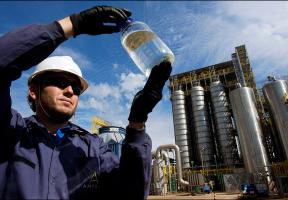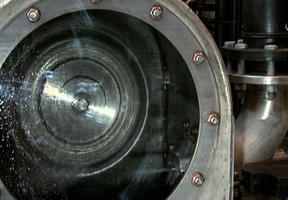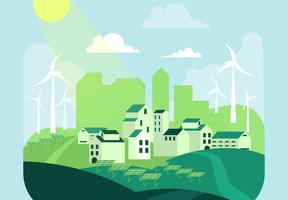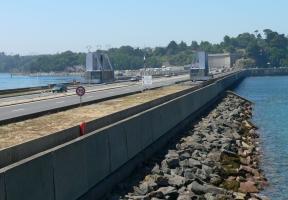Wave Energy: Harnessing the Motion of Waves
5 min read
At sea, the force of the waves is considerable and omnipresent. However, not every country has the same potential. Those with the best exposure have developed different wave energy recovery techniques.

© Wikicommons - The hinged caissons of the Pelamis "sea snake" being assembled in the port at Peniche, Portugal.
Theoretical Efficiency Exceeding That of Wind Energy
The amount of energy generated by waves is small (1 per square meter per year, or 200 times less than direct solar energy), but it is multiplied by the huge surface area offered by the ocean from which this energy can be recovered. According to the World Energy Council, average global wave energy resources are 1.2 TW, equivalent to total installed generation capacity worldwide.
Although present along the coasts of all oceans worldwide, it is greater in some areas, such as the North Atlantic, where capacity is 45 kW per meter, and particularly so off the coasts of the United Kingdom and Ireland. In France, the potential is about 40 TWh per year.
The projected efficiency of wave energy is far higher than for wind power. However, there are significant obstacles to using wave energy:
- of submerged equipment.
- Failure issues related to anchoring equipment at sea and the use of mechanical systems in a highly turbulent environment.
- Environmental issues. Shore-mounted devices can disfigure the landscape, while devices can disrupt marine life, shipping traffic and fishing activities.
A Variety of Techniques
There are several types of wave energy recovery system:
- oscillating water columns capture incoming waves. Water enters a chamber where it compresses the air, driving a turbine that in turn drives an electric generator.
- Submerged oscillating water columns are underwater buoys that rise and fall with the movement of the waves. Anchored to the seabed, their movement activates a piston, draws seawater into a turbine or compresses air or oil that then drives a motor that in turn drives an electric generator.
- Tapered channel systems on banks funnel waves into a channel that gets progressively narrower, causing the waves to rise and spill over the channel walls into a reservoir, gradually filling it up. The water in the reservoir then flows back to the sea through a turbine, generating power in the process.
- Slack-moored wave energy converters direct waves over a ramp, filling up a reservoir that is then emptied to power a turbine. An anchoring device aligns the system so it is perpendicular to the direction of the waves. These “wave dragons” are 200 meters wide and weigh 30,000 tons.
- Pendulor wave energy converters are arrays of caissons linked by hinged flaps forming a sort of sea snake that bobs up and down on the waves. Energy is recovered through the gates between each caisson using pistons that activate pressurized oil pumps.
European Projects
A number of European countries have been developing wave energy technology for over 20 years.
- In France, the SEAREV project was launched in 2003 at the École Centrale de Nantes engineering school. In 2013, studies on commercial development options began. This floating offshore system comprises a closed, sealed floater containing a wheel that acts like a pendulum. The lower half of the wheel, which has a diameter of 9 meters, is weighted with concrete. Waves make the floater oscillate, causing the wheel to move back and forth. Hydraulic pumps connected to the pendulum wheel charge high-pressure accumulators, which discharge their energy into hydraulic motors that then drive electric generators. An underwater cable carries the power to land. Measuring 24 meters long and weighing 1,000 tons, a SEAREV unit will have a capacity of 500 kW. Eventually, wave farms will be built, comprising dozens of devices moored to the seabed 30 to 50 meters below, 5 to 10 kilometers offshore.
- Pelamis’ projects involve arrays of pendulor devices. Created in 1998, Pelamis has already carried out a series of pilot operations, notably in Scotland and Portugal. Pelamis wave energy converters were first connected to the power grid during tests near the Orkney Islands. However, these projects are still seeking investors to enable development of commercial wave farms.
- The Limpet project on the Isle of Islay, Scotland, has been tested since 2000. It uses shoreline oscillating water column (OWC) technology and has a capacity of 500 kW.
- The Wave Dragon prototype1 was launched in Wales in 2007. It uses floating, slack-moored wave energy converter technology and has a capacity of 7 MW.
Sources:




















